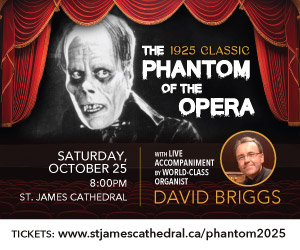Solo performances are the true test of a musician’s mettle. If he or she can keep listeners’ interest throughout an exploration of an instrument’s limits, these skills can be utilized in any situation. Unaccompanied string recitals are as ancient as music itself, but only in the later part of the 20th Century did it become common for other instrumentalists to express their ideas singularly. Improvised music accelerated this process with significant solo saxophone recitals by the likes of Evan Parker and Anthony Braxton. Today seemingly every saxophonist records in a solitary fashion at least once. With these discs we note some of the better recent performances.
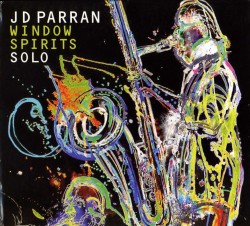 Veteran J D Parran has mastered most members of the woodwind family since the 1970s. On Window Spirits (Mutable 17539-2 www.mutablemusic.com), the American improviser plays unaccompanied alto flute, wooden flute, alto clarinet, clarinet and bass saxophone impeccably, with the last two particular standouts. Spearmanon and C80, for example, both enlarge the bass beast’s customary timbres upwards and downwards so that it sounds comfortable and cleanly melodic, expressing altissimo reed cries as earth-shaking blasts. On the former, constant flattement and an intense vibrato together smear tones all over the sound surface with the pulsating lines as balletic as they are elephantine. On the latter, as his clear-toned melodic extensions vibrate and rattle distinctively, Parran uses circular breathing to play entire chromatic runs in subterranean burps. Elsewhere, Emotions, a clarinet showpiece, expresses a gamut of moods with parallel lines vibrating in counterpoint with one another, congruent but varied in pitch, tone or rhythm. Balladic at times, the spherical lines become polyphonic, creating multiple sonic colours which eventually blend with the initial narrative as the exposition loops back to the beginning.
Veteran J D Parran has mastered most members of the woodwind family since the 1970s. On Window Spirits (Mutable 17539-2 www.mutablemusic.com), the American improviser plays unaccompanied alto flute, wooden flute, alto clarinet, clarinet and bass saxophone impeccably, with the last two particular standouts. Spearmanon and C80, for example, both enlarge the bass beast’s customary timbres upwards and downwards so that it sounds comfortable and cleanly melodic, expressing altissimo reed cries as earth-shaking blasts. On the former, constant flattement and an intense vibrato together smear tones all over the sound surface with the pulsating lines as balletic as they are elephantine. On the latter, as his clear-toned melodic extensions vibrate and rattle distinctively, Parran uses circular breathing to play entire chromatic runs in subterranean burps. Elsewhere, Emotions, a clarinet showpiece, expresses a gamut of moods with parallel lines vibrating in counterpoint with one another, congruent but varied in pitch, tone or rhythm. Balladic at times, the spherical lines become polyphonic, creating multiple sonic colours which eventually blend with the initial narrative as the exposition loops back to the beginning.
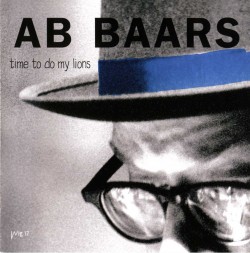 Another reedist with extensive experience leading his own trio and as part of the ICP Orchestra is Ab Baars of the Netherlands. Time to Do My Lions (Wig 17 www.stichingwig.com) finds the Amsterdam-based improviser playing clarinet, tenor saxophone and shakuhachi (Oriental bamboo flute). Like Parran, he has a distinctive solo voice on each instrument, yet is easily able to transfer the techniques from one to another. Case in point is Watazumi Doso, named for a legendary shakuhachi player but played on tenor saxophone. Not only does he invest the sax with non-Western rhythmic pitch and a narrow nasal sound, but his abrasive split tones sound like what would be produced by a blend of Energy Music and Gagaku court music. At the same time Baars is versatile enough to invest The Rhythm is in the Sound, with a collection of abrasive multiphonics, dissonant plus inchoate squeaks, peeps and cries that are atonality incarnate. His clarinet lines are equally descriptive. Crisp reed bites and quivering, liquid runs blend on the title tune in such an unaffected manner that the piece advances linearly, despite the quivering altissimo screams punctuating the final section. A similar strategy appears on Rittratto dal mare a Anzio, where the finale of languid and breathy tones logically follows from the reed partials exposed as fortissimo squeaks and extended, quivering glissandi. Elsewhere shakuhachi lines are appropriately delicate and legato.
Another reedist with extensive experience leading his own trio and as part of the ICP Orchestra is Ab Baars of the Netherlands. Time to Do My Lions (Wig 17 www.stichingwig.com) finds the Amsterdam-based improviser playing clarinet, tenor saxophone and shakuhachi (Oriental bamboo flute). Like Parran, he has a distinctive solo voice on each instrument, yet is easily able to transfer the techniques from one to another. Case in point is Watazumi Doso, named for a legendary shakuhachi player but played on tenor saxophone. Not only does he invest the sax with non-Western rhythmic pitch and a narrow nasal sound, but his abrasive split tones sound like what would be produced by a blend of Energy Music and Gagaku court music. At the same time Baars is versatile enough to invest The Rhythm is in the Sound, with a collection of abrasive multiphonics, dissonant plus inchoate squeaks, peeps and cries that are atonality incarnate. His clarinet lines are equally descriptive. Crisp reed bites and quivering, liquid runs blend on the title tune in such an unaffected manner that the piece advances linearly, despite the quivering altissimo screams punctuating the final section. A similar strategy appears on Rittratto dal mare a Anzio, where the finale of languid and breathy tones logically follows from the reed partials exposed as fortissimo squeaks and extended, quivering glissandi. Elsewhere shakuhachi lines are appropriately delicate and legato.
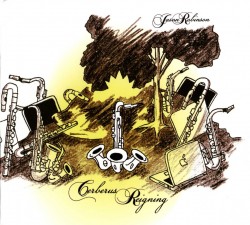 San Diego’s Jason Robinson introduces different textures to his timbral examination of alto and tenor saxophones plus alto flute on Cerberus Rising (Accretions ALP51 www.accretions.com). The 16 solo improvisations are frequently modified with effects and samples from musical software. Staying spontaneous, there are no edits or overdubs as Robinson alters his reed lines in real time. For instance the title track is quickly mutated from what could be the demarcated expression of a lone tenor saxophone to a variant of a saxophone choir, with the other overdubbed horns vibrating echo-chamber-like effects over which the first saxophone improvises. The reverberating reeds blurrily expose thematic variants sped up to cartoon music velocity, until legato sax timbres reappear and complete the narrative. Alternately, as on Serpentine Gaze, the saxophone’s wide vibrato is processed to such an extent that the higher-pitched results sound as if Ebb Tide is being played on a wind synthesizer. A genuine watery overlay is present on Rising Tide for Humanity as field recordings of thunderstorms and lapping waves share space with computer-processed buzzes, and then give way to staccato saxophone tones that reverberate on top of fan-belt-like clangs from the software. Syrynx at the Edge of Nightfall on the other hand frames a lyrical flute line with whistling, echoing and wobbly wave forms. These computer pulsations stretch time by not only bubbling underneath, but also by commenting discordantly on the initial exposition.
San Diego’s Jason Robinson introduces different textures to his timbral examination of alto and tenor saxophones plus alto flute on Cerberus Rising (Accretions ALP51 www.accretions.com). The 16 solo improvisations are frequently modified with effects and samples from musical software. Staying spontaneous, there are no edits or overdubs as Robinson alters his reed lines in real time. For instance the title track is quickly mutated from what could be the demarcated expression of a lone tenor saxophone to a variant of a saxophone choir, with the other overdubbed horns vibrating echo-chamber-like effects over which the first saxophone improvises. The reverberating reeds blurrily expose thematic variants sped up to cartoon music velocity, until legato sax timbres reappear and complete the narrative. Alternately, as on Serpentine Gaze, the saxophone’s wide vibrato is processed to such an extent that the higher-pitched results sound as if Ebb Tide is being played on a wind synthesizer. A genuine watery overlay is present on Rising Tide for Humanity as field recordings of thunderstorms and lapping waves share space with computer-processed buzzes, and then give way to staccato saxophone tones that reverberate on top of fan-belt-like clangs from the software. Syrynx at the Edge of Nightfall on the other hand frames a lyrical flute line with whistling, echoing and wobbly wave forms. These computer pulsations stretch time by not only bubbling underneath, but also by commenting discordantly on the initial exposition.
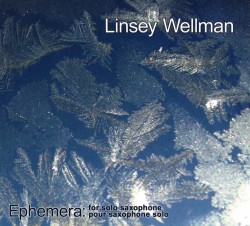 The preceding elaborate reed reconfigurations make Ottawa-based alto saxophonist Linsey Wellman’s Ephemera (www.linseywellman.com) seem almost quaint in its adherence to the initial unaccompanied saxophone strategies of the likes of Braxton and Parker. Unadorned except for his saxophone, Wellman uses repeated and carefully divided lines to vibrate split tones which are somehow both polyphonic and tonic. Using circular breathing he produces equivalent note clusters and glissandi that unroll as if his saxophone is a perpetual motion machine yet subtly vary in pitch, shading and emphasis. Systematically playing at a level of unabashed intensity, thematic variations aren’t neglected no matter how rough and staccato his performance. Moreover melodic inferences are never far from the surface, as on Track 9, where slurred textures and reed pressure quirkily hint at an atonal variant of Harlem Nocturne. As spectacularly, fortissimo and staccato cries, reed percussion and shaded multiphonics on Track 3, seem to be produced by sheer mouth, lip and breath control. Wellman’s unvarnished, understated, perhaps by definition, Canadian, extended techniques suggest that his saxophone skills could eventually reach Baars or Parran level. His CD certainly confirms that plenty of sounds remain to be exposed in solo saxophone sets.
The preceding elaborate reed reconfigurations make Ottawa-based alto saxophonist Linsey Wellman’s Ephemera (www.linseywellman.com) seem almost quaint in its adherence to the initial unaccompanied saxophone strategies of the likes of Braxton and Parker. Unadorned except for his saxophone, Wellman uses repeated and carefully divided lines to vibrate split tones which are somehow both polyphonic and tonic. Using circular breathing he produces equivalent note clusters and glissandi that unroll as if his saxophone is a perpetual motion machine yet subtly vary in pitch, shading and emphasis. Systematically playing at a level of unabashed intensity, thematic variations aren’t neglected no matter how rough and staccato his performance. Moreover melodic inferences are never far from the surface, as on Track 9, where slurred textures and reed pressure quirkily hint at an atonal variant of Harlem Nocturne. As spectacularly, fortissimo and staccato cries, reed percussion and shaded multiphonics on Track 3, seem to be produced by sheer mouth, lip and breath control. Wellman’s unvarnished, understated, perhaps by definition, Canadian, extended techniques suggest that his saxophone skills could eventually reach Baars or Parran level. His CD certainly confirms that plenty of sounds remain to be exposed in solo saxophone sets.



